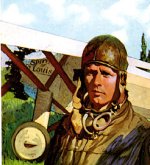
Worksheets and No Prep Teaching Resources
Reading Comprehension Worksheets
The 1920's

The 1920's
 Worksheets and No Prep Teaching Resources Reading Comprehension Worksheets The 1920's |
 The 1920's |
| edHelper's suggested reading level: | grades 5 to 7 | |
| Flesch-Kincaid grade level: | 4.19 |
|
"Lucky Lindy" Takes the Bait, Part 2
By Toni Lee Robinson |

|
 1 War pilots and barnstormers gave airplanes a start. The airmail service made them a part of everyday life. Who would take air travel to the next level? Raymond Orteig, a New York businessman, decided to raise the stakes in the aviation game. He offered a prize of $25,000 to the first person to fly non-stop between New York and Paris. The offer was first made in 1919. Several tried for the honor. Some had been killed or badly injured. Some had simply vanished over the Atlantic.
1 War pilots and barnstormers gave airplanes a start. The airmail service made them a part of everyday life. Who would take air travel to the next level? Raymond Orteig, a New York businessman, decided to raise the stakes in the aviation game. He offered a prize of $25,000 to the first person to fly non-stop between New York and Paris. The offer was first made in 1919. Several tried for the honor. Some had been killed or badly injured. Some had simply vanished over the Atlantic. |
Create Weekly Reading Books
Prepare for an entire week at once! |
| Leave your feedback on "Lucky Lindy" Takes the Bait, Part 2 (use this link if you found an error in the story) |
 |
The 1920's
|
 |
United States
|
|
|
 | Fifty States Theme Unit |
 |
Document Based Activities |